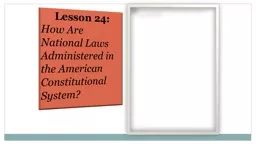

Purpose Departments agencies and bureaus that administer laws bureaucracy touch every aspect of American life This lesson examines the role of administrative departments and agencies in Americas national government ID: 659989
Download Presentation The PPT/PDF document "Lesson 24: How Are National Laws Adminis..." is the property of its rightful owner. Permission is granted to download and print the materials on this web site for personal, non-commercial use only, and to display it on your personal computer provided you do not modify the materials and that you retain all copyright notices contained in the materials. By downloading content from our website, you accept the terms of this agreement.
Slide1
Lesson 24:How Are National Laws Administered in the American Constitutional System?Slide2
PurposeDepartments, agencies, and bureaus that administer laws (bureaucracy) touch every aspect of American life.This lesson examines the role of administrative departments and agencies in America’s national government.Slide3
Objectives
Explain why Congress create administrative units, the circumstances that contribute to their creation, and the range of governmental functions that administrative perform.
Identify some of the checks on the exercise of administrative power.
Evaluate, take and defend positions on public administration in the United States. Slide4
Terms to Know bureaucracy Governmental departments and agencies and their staffs, principally civil service members and political appointees.
cabinet
The group of advisors to the president composed of the heads of the departments of the executive branch and certain other officials. Cabinet advice to U.S. presidents is not binding, as opposed to parliamentary systems, where the consensus of cabinets is said to bind prime ministers.
civil service
Employment in federal, state or provincial, and local governmental agencies. The civil service was formed in an effort to reduce political patronage and promote professionalism in government.
independent agencies
Administrative organizations located outside the structure of executive departments. Slide5
Kinds of Administrative UnitsExecutive DepartmentsCongress directs each to administer certain laws / President appoints each secretary, or “head” (Cabinet)Currently 15 departments, each head in line of successionExecutive Office of the President (EOP)
Created in 1939 to help with budgeting, personnel management, and natural resources planning.
Includes: White House Office, Office of
Management & Budget, Council of
Economic Advisors, National Security
CouncilSlide6
Kinds of Administrative UnitsIndependent AgenciesLocated outside structure of Executive DepartmentsGranted quasi-legislative regulatory powersEx) Environmental Protection Agency (EPA), Peace
Corps
Others
Federal Emergency Management Association (FEMA)
Was independent agency, now part of Dept. of Homeland Security
US Postal Service
Government corporation
Federal Communications Commission (FCC)
Designed to enforce regulations of the industrySlide7
Administrative OrganizationsQuasi-legislative powers delegated to implement broad congressional mandates. Rules published in Federal RegisterSome units granted quasi-judicial powers Hearings held to resolve disputesExample: IRS
Makes & Enforces rules about tax collections. Also holds hearings for those accused of violations.
Administrative Procedure Act (1946)
Established rules to implement laws, requires public notice / hearings, permits judicial review of administrative decisionsSlide8
Contributing FactorsGrowth in response to demands placed on gov’tEx) Industrial Revolution lead to Dept. of Commerce and Labor, Interstate Commerce Commission, and Federal Trade Commission Great Depression / New DealFDR creates significant growth in federal bureaucracy in response to national crises
Cold War
Dept. of Defense, National Security Council,
CIA…Slide9
Contributing FactorsReductionStarting in 1970s, many commissions and boards abolishedEx) Interstate Commerce Commission9/11Terrorist attacks result in creation of Department of Homeland SecuritySlide10
Staffing Administrative AgenciesCivil Service1883 – Patronage substituted for merit-based system / administrative class insulated from politicsCongress sill establishes office requirements, performance standards, wages, benefits, & “whistle-blower” protectionsHatch Act (1939)
Parties prohibited from pressuring workers to contribute or work for candidates in exchange for job security
President makes appointments to
key leadership positions
Helps ensure bureaucracy enacts his
policy agenda
With new administration’s usually
complete change in leadershipSlide11
Checks & BalancesThe PresidentAppointment power rewards loyalists / advances agendaExecutive Orders – directs agencies to take certain actionsCongressCreates, consolidates, or eliminates agenciesSenate confirms high-level appointees
Statutes direct agency actions
Appropriates funding
Congressional Oversight
Ex) review budgets, investigate actionsSlide12
Checks & BalancesCourtsDecide whether agencies violate 14th Amendment due process & equal protection requirementsRequires Congress to clearly define agency standardsFederalismIf state and national policies differ, states sometimes resist or refuse to comply with standards (ex. Education reform)
Citizens, Interest Groups, Media
Those directly affected by public policy ca monitor actions, report complaints, or investigate issues regarding problems and injustice in the bureaucracy